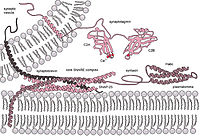
Photo from wikipedia
Lysosomal exocytosis is involved in many key cellular processes but its spatiotemporal regulation is poorly known. Using total internal reflection fluorescence microscopy (TIRFM) and spatial statistics, we observed that lysosomal… Click to show full abstract
Lysosomal exocytosis is involved in many key cellular processes but its spatiotemporal regulation is poorly known. Using total internal reflection fluorescence microscopy (TIRFM) and spatial statistics, we observed that lysosomal exocytosis is not random at the adhesive part of the plasma membrane of RPE1 cells but clustered at different scales. Although the rate of exocytosis is regulated by the actin cytoskeleton, neither interfering with actin or microtubule dynamics by drug treatments alters its spatial organization. Exocytosis events partially co-appear at focal adhesions (FAs) and their clustering is reduced upon removal of FAs. Changes in membrane tension following a hypo-osmotic shock or treatment with methyl-β-cyclodextrin were found to increase clustering. To investigate the link between FAs and membrane tension, cells were cultured on adhesive ring-shaped micropatterns, which allow to control the spatial organization of FAs. By using a combination of TIRFM and fluorescence lifetime imaging microscopy (FLIM), we revealed the existence of a radial gradient in membrane tension. By changing the diameter of micropatterned substrates, we further showed that this gradient as well as the extent of exocytosis clustering can be controlled. Together, our data indicate that the spatial clustering of lysosomal exocytosis relies on membrane tension patterning controlled by the spatial organization of FAs.
Journal Title: Proceedings of the National Academy of Sciences of the United States of America
Year Published: 2023
Link to full text (if available)
Share on Social Media: Sign Up to like & get
recommendations!